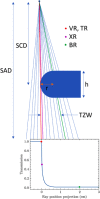Static MLC transmission simulation using two-dimensional ray tracing
- PMID: 35596533
- PMCID: PMC9359033
- DOI: 10.1002/acm2.13646
Static MLC transmission simulation using two-dimensional ray tracing
Abstract
Purpose: We investigated the hypothesis that the transmission function of rounded end linearly traveling multileaf collimators (MLCs) is constant with position. This assumption is made by some MLC models used in clinical treatment planning systems (TPSs) and in the Varian MLC calibration convention. If not constant, this would have implications for treatment plan QA results.
Methods: A two-dimensional ray-tracing tool to generate transmission curves as a function of leaf position was created and validated. The curves for clinically available leaf tip positions (-20 to 20 cm) were analyzed to determine the location of the beam edge (half-attenuation X-ray [XR]) location, the beam edge broadening (BEB, 80%-20% width), as well as the leaf tip zone width. More generalized scenarios were then simulated to elucidate trends as a function of leaf tip radius.
Results: In the analysis of the Varian high-definition MLC, two regions were identified: a quasi-static inner region centered about central axis (CAX), and an outer one, in which large deviations were observed. A phenomenon was identified where the half-attenuation ray position, relative to that of the tip or tangential ray, increases dramatically at definitive points from CAX. Similar behavior is seen for BEB. An analysis shows that as the leaf radius parameter value is made smaller, the size of the quasi-static region is greater (and vice versa).
Conclusion: The MLC transmission curve properties determined by this study have implications both for MLC position calibrations and modeling within TPSs. Two-dimensional ray tracing can be utilized to identify where simple behaviors hold, and where they deviate. These results can help clinical physicists engage with vendors to improve MLC models, subsequent fluence calculations, and hence dose calculation accuracy.
Keywords: HDMLC calibration; MLC modeling; ray tracing.
© 2022 The Authors. Journal of Applied Clinical Medical Physics published by Wiley Periodicals, LLC on behalf of The American Association of Physicists in Medicine.
Conflict of interest statement
BB is a cofounder and has an ownership interest in Voximetry, Inc., a nuclear medicine dosimetry company in Madison, WI.
Figures









Similar articles
-
Spatial variation of dosimetric leaf gap and its impact on dose delivery.Med Phys. 2014 Nov;41(11):111711. doi: 10.1118/1.4897572. Med Phys. 2014. PMID: 25370625
-
Monte Carlo modeling and simulations of the High Definition (HD120) micro MLC and validation against measurements for a 6 MV beam.Med Phys. 2012 Jan;39(1):415-23. doi: 10.1118/1.3671935. Med Phys. 2012. PMID: 22225311
-
Optimizing the MLC model parameters for IMRT in the RayStation treatment planning system.J Appl Clin Med Phys. 2015 Sep 8;16(5):322–332. doi: 10.1120/jacmp.v16i5.5548. J Appl Clin Med Phys. 2015. PMID: 26699315 Free PMC article.
-
Monte Carlo implementation, validation, and characterization of a 120 leaf MLC.Med Phys. 2011 Oct;38(10):5311-20. doi: 10.1118/1.3626485. Med Phys. 2011. PMID: 21992349
-
Testing of an enhanced leaf model for improved dose calculation in a commercial treatment planning system.Med Phys. 2022 Dec;49(12):7754-7765. doi: 10.1002/mp.16019. Epub 2022 Oct 17. Med Phys. 2022. PMID: 36190516
Cited by
-
Multileaf Collimator Modeling and Commissioning for Complex Radiation Treatment Plans Using 2-Dimensional (2D) Diode Array MapCHECK2.Technol Cancer Res Treat. 2024 Jan-Dec;23:15330338231225864. doi: 10.1177/15330338231225864. Technol Cancer Res Treat. 2024. PMID: 38311933 Free PMC article.
References
MeSH terms
LinkOut - more resources
Full Text Sources

